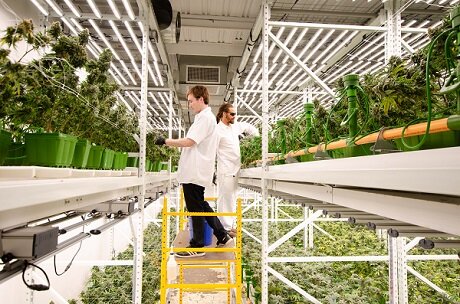Jan 14, 2021
"The Vertical Farm Industry Can Learn A Lot From Cannabis Growers"

Image sourced from Vertical Farm Daily
CONTENT SOURCED FROM VERTICAL FARM DAILY
WRITTEN BY: ANDREA DI PASTENA
Vertical farming has seen a growing trend in the last few years, as it enables growers to combine environmental and financial sustainability. At the same time, designing the facilities is still a rather new endeavor. Growers need to rely on the right consultant and supplier if they want to kick off their operation on the right foot. The complexity of vertical farming requires an adequate level of knowledge about both the designing stage of the facility as well as the growing of the product.
“The first and biggest mistake that I have seen is underestimating the load of the HVAC, particularly when it’s associated with dehumidification,” Brandy Keen with Surna explains. “This is also a consequence of other factors: budget consideration, above all. I think that, generally speaking, people underestimate how much of the budget the HVAC is going to take up. I don’t believe that mistakes start with trying to be cheap, but rather with hiring inexperienced engineers to do the load calculations. If an engineer has never worked in this industry, they won’t know how to approach biosecurity, dehumidification, or how the load calculations effect the life cycle of the plant. This will inevitably result in problems during the cultivation stages.”
Learning from cannabis
Vertical farming is still a rather young industry. However, there is another relatively young industry that has been utilizing vertical farming successfully. “There aren’t many vertical farms yet, and so to a certain extent, it’s new to everyone,” Brandy points out. “The vertical farm industry can learn a lot from the cannabis industry. The more experienced engineers, like us, have gathered there. At Surna, we have a lot of experience in designing controlled environments, cultivation lighting, and irrigation methodologies. Vertical farms can certainly take some lessons from the cannabis industry.”
One of the most important lessons is understanding the whole growing process. “It is crucial to rely on a control system that gives you visibility into the operation of your facility,” Brandy remarks. “It is critical to collect data not only about the cultivation itself, but also about the equipment; as cannabis teaches us, this isn’t only about farming, but even more about industrial manufacturing.”
Food production
This is especially relevant because vertical farming will play an essential role in food production in the future worldwide. “The appeal of vertical farming is more than just the lower prices,” she says. “There’s a certain appeal to organic production, as it appeals to people in the same way Whole Foods appeals to people. It feels healthier, and it is healthier. In the long run, we will find that cultivating in a controlled environment is going to be necessary in food production because our water resources are increasingly unstable, the amount of pollution associated with traditional agriculture is not particularly sustainable, and the amount of carbon production due to transportation is problematic. As we focus on energy efficiency and reduction of operating cost, we can drive down the cost of local food production significantly. Besides, it provides more food security as you are going to be able to grow food around the corner. This is the long-term value.”
When it comes to cost-effectiveness, this is where Surna comes in. “We have the expertise to understand the way energy is used in controlled environment agriculture (CEA),” she says. “We understand that drawing an energy model for a residential home is not the same as an energy model for a commercial building. We apply that expertise to create the most energy-efficient way to operate that facility. It is about finding that balance between perfecting the environment and minimizing energy use. We have built this expertise over our 15 years in indoor cultivation.”
Overcoming microclimates
Based on this experience, Brandy is very aware of one of the biggest challenges in vertical farms. “Microclimates,” she says. “A solution for this would be to move more air around. The problem with that, however, is that when you start to actively work with air velocity, you might find that this has an opposite effect. I think the biggest issue is that microclimates have historically been seen as a separate component of the HVAC. You use one system for heat and humidity, and then you use another system to move the air around. But if you have the HVAC dumping in the fresh air, and a dehumidifier transporting cold air, hot spots are inevitable. It is hard to avoid this if you don’t consider airflow as being an essential part of the climate control system. They are in fact one and the same. Once you have considered the airflow patterns, then it’s just a part of your mechanical design. Some time ago, we worked on a project with a young company that was on a tight budget. However, we helped them to come into the market, and we are very excited to see that they have grown considerably, and we couldn’t be prouder of what they have accomplished with our guidance.”
FURTHER READING:

